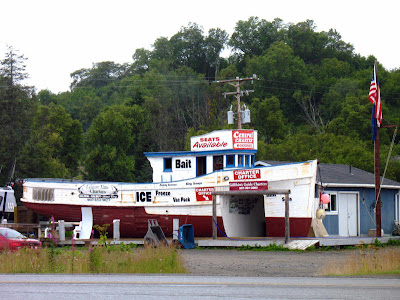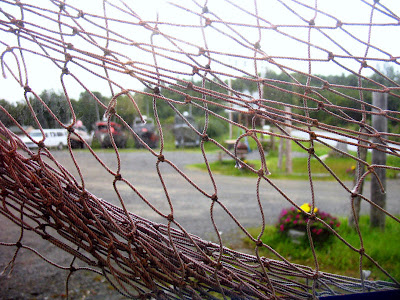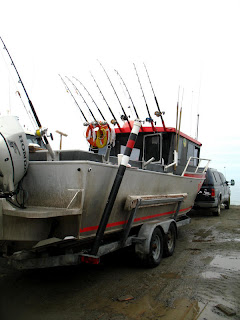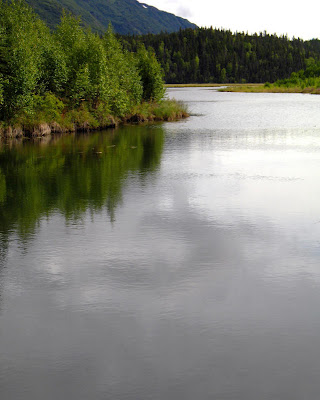 Space: the next frontier (final?)
Space: the next frontier (final?)This month's
Accretionary Wedge is all about "Geologeeeeee in Spaaaaaaaace," as Chris over at
goodSchist pronounces it!
I got to thinking about mining in spaaaace, and found some interesting links that have to do with mining meteorites on earth, and some results of meteor impacts.
But first off, mining in space - in the asteroid belt or anywhere else - is not likely to happen anytime soon, IMO. Numerous people, however, have been looking into it, perhaps at least as long as we have been actively exploring space, beginning with our 1960's race to the moon.
Asteroids are small metallic to rocky bodies in our solar system that are
too small to be considered planets. That definition is a little fuzzy, as we have found out recently with the de-classification of
Pluto from a planet to, well, a dwarf planet, which is something between an asteroid and a planet in size.
The main grouping of asteroids occurs in the asteroid belt between Mars and Jupiter. These asteroids are thought to be what's left of primordial or proto-planetary matter that did not form a planet because of interference by the large gravitational field of nearby Jupiter. Asteroids also occur in Jupiter's
Lagrange points; these asteroids are known as Trojans. Finally, there are asteroids that approach relatively close to Earth, and they are called Near Earth Asteroids (NEA's).
Asteroids can also be classified by composition. The classification of asteroids into
C-type, S-type, and M-type, along with several other minor types, is based on the study of
meteors that enter earth's orbit and then survive as on-the-ground
meteorites. Chris at goodSchist describes in detail
one of the C-type asteroids, Ivuna, and Geology Happens has some info about
asteroid impacts and the craters they form.
Asteroid mining, as I mentioned, was the first type of mining that came to my mind when I thought of mining in space. The several different kinds of asteroids have potentially many different kinds of minerals or elements that a reasonable miner might want to go after in space. These elements include
gold and platinum,
aluminum, magnesium, nickel, cobalt, platinum, and titanium,
aluminium, gold, silver, zinc and other base and precious metals, and a
whole host of resources depending on asteroid type:
C, D, P: H2O, CO2, CH4
B, G, F: nickel and iron
Q, S, M: nickel, iron, silicates, and platinum group elements
Apparently - and probably not surprisingly - the Near Earth Asteroids have been voted "most likely to be mined" by those doing initial feasibility studies. C-type asteroids are favored by some, not only for their iron, aluminum, magnesium, nickel, cobalt, and platinum, but also for other commodities and mineral sources such as ice, hydrocarbons, graphite, silicates, sulfides and sulfates, nitrates, and carbonates. The current feasibility and accuracy of these plans and ideas is beyond the scope of this little blog article!
Meteorite impacts on earth have led to some interesting mining speculation, the foremost of which started after G. K. Gilbert, in the 1890's, decided that the Barringer Meteor Crater in Arizona was caused by an underground steam explosion - because he could find no meteor-impact evidence, such as an intact meteorite. In 1902, Daniel Moreau Barringer, an American mining engineer, decided that the crater, which he recognized as a meteorite impact crater, had great iron and nickel mining potential, if only the meteorite that had created the crater could be found. He drilled the area for twenty years without finding what he was looking for, at the same time finding geologic evidence that eventually led to the acceptance of the site as an impact crater.
Others have occasionally proposed exploring for impact sites as a way to find certain metals and commodities, such as gold, platinum, and diamonds. It's not clear to me whether these are viable exploration models, or whether they are, in large part, based on the fact that the Sudbury mining district in Canada, a large source of nickel, copper, cobalt, and platinum group elements, is the site of a huge meteorite impact that occurred 1.8 billion years ago. The metals in the 30 x 60 km Sudbury basin are not currently thought to have come from the meteorite, but from the earth itself. The story of the Sudbury impact and resulting melting of the earth's crust can be read about here, here, and here. From Naldrett, 2003:
...there is a growing body of isotopic evidence that the complex is an impact melt that incorporated Ni-, Cu-, and PGE–bearing mafic and/or ultramafic rocks that were already present in the target area (Keays and Lightfoot, 1999; Cohen et al., 2000).
In other space-mining news, mining on the moon may succeed sooner than asteroid mining, if NASA builds its moon base, and if mining Helium-3 for fusion-generated energy proves worthwhile. The most recent moon-base proposal, however, doesn't seem to require any off-world mining.
A Few References:
Cohen, A.S., Burnham, O.M., Hawkesworth, C.J., Lightfoot, P.C., 2000, Pre-emplacement Re-Os ages from ultramafic inclusions in the Sublayer of the Sudbury Igneous Complex, Ontario: Chemical Geology, v. 165, p. 37–46.
Keays, R.R., Lightfoot, P.C., 1999, The role of meteorite impact, source rocks, protores and mafic magmas in the genesis of the Sudbury Ni-Cu-PGE sulfide ore deposits, in Keays, R.R., et al., eds., Dynamic processes in magmatic ore deposits and their application in mineral exploration: Geological Association of Canada, Short Course Notes, v. 13, p. 329–366.
Naldrett, A. J., 2003, From Impact to Riches: Evolution of Geological Understanding as Seen at Sudbury, Canada: Geological Society of America, GSA Today, vol. 13, issue 2, p. 4-9.
Accretionary Wedge #13: Geology in Space


 These photos were taken last year in the Duck Creek Range and southern Schell Creek Range of eastern Nevada. This year, the trees seem to be changing color slowly, more slowly than last year. The aspens on Austin Summit, for example, were green just a few days ago. So I don't expect to find very good examples of our local Nevada color before my next days off, maybe some distant ones. For other inspiring autumn photos see Wayfarer Scientista (Colorado, I think) and Apparent Dip (Alaska).
These photos were taken last year in the Duck Creek Range and southern Schell Creek Range of eastern Nevada. This year, the trees seem to be changing color slowly, more slowly than last year. The aspens on Austin Summit, for example, were green just a few days ago. So I don't expect to find very good examples of our local Nevada color before my next days off, maybe some distant ones. For other inspiring autumn photos see Wayfarer Scientista (Colorado, I think) and Apparent Dip (Alaska).













































